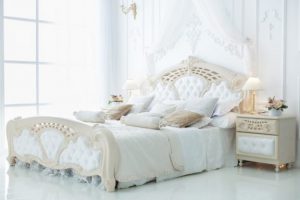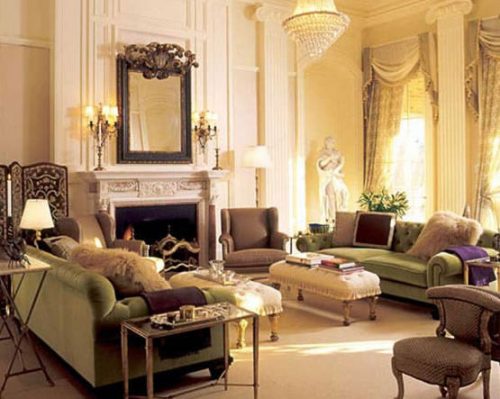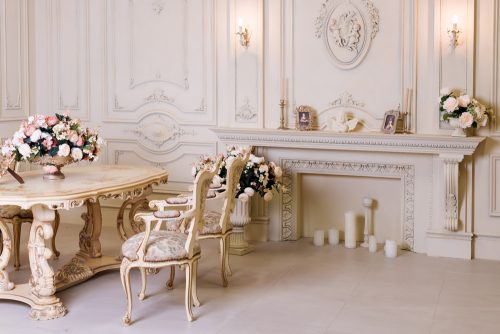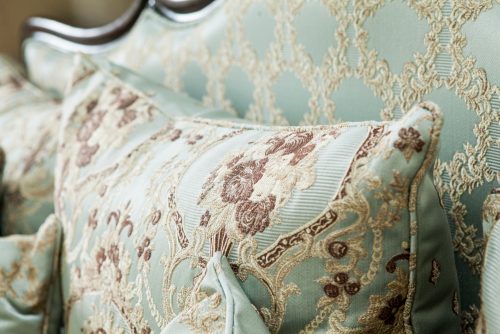Baroque Decor

If you’re looking to change your home decor or want to incorporate an artistic concept into your interior design, a great idea could be baroque decor.
Throughout history, various artistic periods have had an influence on interior design. Since medieval times, many palaces have used a gallant and refined decor. That gallantry has always been associated with high social class.
However, one particular style really influenced decor with a spirit that was truly innovative for its time: the baroque style.
The baroque style: what is it?

Principally, baroque is an artistic style that pays special attention to details. It aims to adorn and stimulate decor by using incredibly sophisticated finishes and trims. It denotes an interest in perfect art as well as architecture, music, painting, etc.
In the world of interior design, furniture is the main element that creates a baroque style. The furniture is where we can use the same decor that was used in the seventeenth and eighteenth centuries.
This style is very similar to the classical style and transports us to an elegant setting. Consequently, you can’t use it with minimalist or rustic decor.
Baroque furniture
The furniture that you use in your home needs to have a refined design that uses detailed trims. What kind of characteristics can we find in the baroque style?

- Curves and dynamism: curves are an indispensable design element, just as on altarpieces of baroque churches. Both tables and chairs have these curves that add dynamism to their design.
- Breaking the straight line: it’s all about creating internal movement and breaking free from fixed forms and rigidness. This look doesn’t have fixed shapes but expresses joy through art.
- Reinforcement: a furniture piece might not just be curved; it can also be paired with fabric or covers with colorful patterns.
- Elegant colors: to create a baroque feeling gold and silver work well. For example, a mirror that uses either of these colors will stand out and transmit elegance.
- Wood: whether it’s for furniture or the floor, any feature projects the baroque character if it’s made of wood.
– How can you summarize the baroque style in 4 words? Appreciation for intricate details. –
Decorative elements

First off, you have to remember that decor has to maintain a balance. You can’t use items of a different style, as this will create tension. But you can use the following:
- Tables: they should be wood, but you can also use wooden tables with a stone top like marble. Look for curved legs and edges with decorative natural or stone trims.
- Chairs: chairs might have curved legs and backs with natural decor or trim as well. Or, they might just have simple, more defined lines that have a clear sense of dynamism. Try to avoid options that are more rigid.
- Mirrors: mirrors are circular or oval with a curved, extremely detailed and defined frame. Just as we mentioned previously, gold and silver work well for mirrors.
- Wall paintings: decorating walls with paintings was a common decor practice in the seventeenth and eighteenth centuries. Just make sure not to use contemporary pieces.
- Chandeliers: these light fixtures are a must for baroque rooms because they offer incredible elegance and glamor. A chandelier will undoubtedly be a beautiful decor element.
- Fabrics: curtains and tablecloths adorned with lace.
What does the this decor express?
The baroque style transports a home to a time when home decor mattered a lot. It was important to impress guests with an elegant decor in all its glory. These days, it might not be as common as it was, but if you want your home to be a refined space, search for the elements that’ll help you create the style.
If you’re looking to change your home decor or want to incorporate an artistic concept into your interior design, a great idea could be baroque decor.
Throughout history, various artistic periods have had an influence on interior design. Since medieval times, many palaces have used a gallant and refined decor. That gallantry has always been associated with high social class.
However, one particular style really influenced decor with a spirit that was truly innovative for its time: the baroque style.
The baroque style: what is it?

Principally, baroque is an artistic style that pays special attention to details. It aims to adorn and stimulate decor by using incredibly sophisticated finishes and trims. It denotes an interest in perfect art as well as architecture, music, painting, etc.
In the world of interior design, furniture is the main element that creates a baroque style. The furniture is where we can use the same decor that was used in the seventeenth and eighteenth centuries.
This style is very similar to the classical style and transports us to an elegant setting. Consequently, you can’t use it with minimalist or rustic decor.
Baroque furniture
The furniture that you use in your home needs to have a refined design that uses detailed trims. What kind of characteristics can we find in the baroque style?

- Curves and dynamism: curves are an indispensable design element, just as on altarpieces of baroque churches. Both tables and chairs have these curves that add dynamism to their design.
- Breaking the straight line: it’s all about creating internal movement and breaking free from fixed forms and rigidness. This look doesn’t have fixed shapes but expresses joy through art.
- Reinforcement: a furniture piece might not just be curved; it can also be paired with fabric or covers with colorful patterns.
- Elegant colors: to create a baroque feeling gold and silver work well. For example, a mirror that uses either of these colors will stand out and transmit elegance.
- Wood: whether it’s for furniture or the floor, any feature projects the baroque character if it’s made of wood.
– How can you summarize the baroque style in 4 words? Appreciation for intricate details. –
Decorative elements

First off, you have to remember that decor has to maintain a balance. You can’t use items of a different style, as this will create tension. But you can use the following:
- Tables: they should be wood, but you can also use wooden tables with a stone top like marble. Look for curved legs and edges with decorative natural or stone trims.
- Chairs: chairs might have curved legs and backs with natural decor or trim as well. Or, they might just have simple, more defined lines that have a clear sense of dynamism. Try to avoid options that are more rigid.
- Mirrors: mirrors are circular or oval with a curved, extremely detailed and defined frame. Just as we mentioned previously, gold and silver work well for mirrors.
- Wall paintings: decorating walls with paintings was a common decor practice in the seventeenth and eighteenth centuries. Just make sure not to use contemporary pieces.
- Chandeliers: these light fixtures are a must for baroque rooms because they offer incredible elegance and glamor. A chandelier will undoubtedly be a beautiful decor element.
- Fabrics: curtains and tablecloths adorned with lace.
What does the this decor express?
The baroque style transports a home to a time when home decor mattered a lot. It was important to impress guests with an elegant decor in all its glory. These days, it might not be as common as it was, but if you want your home to be a refined space, search for the elements that’ll help you create the style.
All cited sources were thoroughly reviewed by our team to ensure their quality, reliability, currency, and validity. The bibliography of this article was considered reliable and of academic or scientific accuracy.
R. Snyder, Jon: La estética del Barroco, Léxico de estética, 2014.







